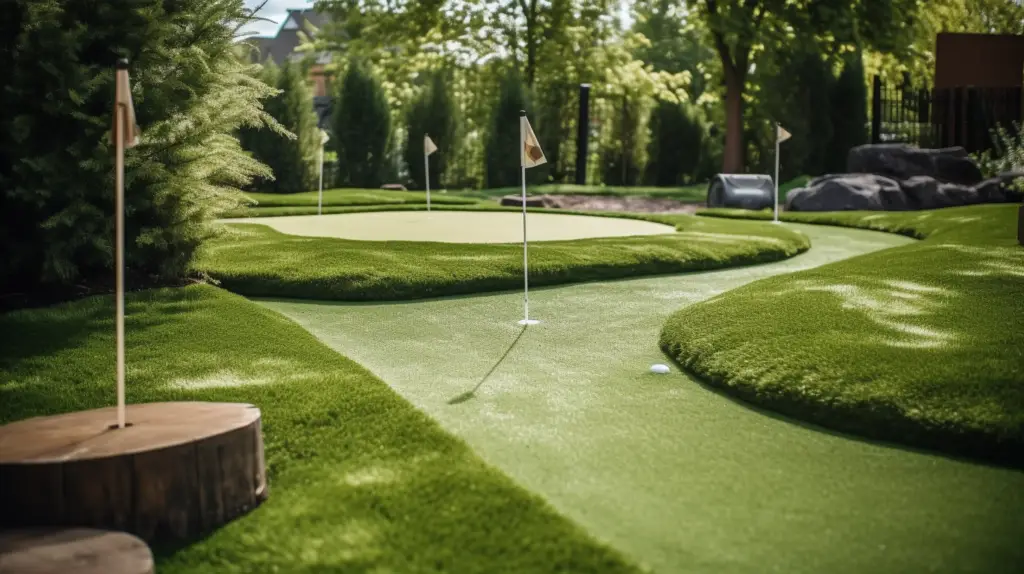Last Updated on October 25, 2023
Mini golf is a popular game and activity for people of all ages. It presents an exciting opportunity for individuals to create their own course in the comfort of their backyard, bringing entertainment to any outdoor space. This article will provide detailed instructions on how to make a mini golf course in your backyard from scratch that can be enjoyed by family and friends alike.
Planning and Design
Planning and designing a mini golf course in the backyard requires careful consideration of available space, desired obstacles, and budget. The layout is determined by how much terrain can be used and what objects are already present in the backyard; for example, trees or shrubs may be built around to create natural hazards on the course.
Another factor to consider when planning is budget; different materials have varying costs associated with them that should not exceed one’s financial capacity. With all these factors taken into account, an appropriate design plan can be created that meets both practical and aesthetic requirements. To ensure adequate playability of the course, it is advisable to test out possible layouts before settling on a final version.
Materials Needed
The materials needed to construct a mini golf course in the backyard are easily accessible and relatively inexpensive. The first item that is necessary for the construction of the course is putting green turf, which provides a realistic surface for play. Golf flags should be placed around the perimeter of each hole so that players know where their ball needs to land to complete the hole successfully.
Additionally, sand traps can be added as obstacles along the way by using a sand trap liner. These liners help keep loose sand from spilling out onto surrounding areas and also allow players an easier time retrieving their ball once it has landed in a bunker.
Location Selection
When constructing a mini golf course in the backyard, selecting an ideal location is essential. It is important to consider the size of the backyard when determining where to place each hole. If the space available for construction is limited, it may be necessary to choose fewer holes and create a shorter course. Additionally, it may be beneficial to plan out a landscaping idea to provide adequate protection around each hole from wind or other outdoor elements.
Setting Up the Course

The setup of a mini golf course in one’s backyard is an exciting and creative endeavour. When setting up the course, it is important to consider the size of the space available for play and the desired difficulty level.
To begin constructing your mini golf course:
- Choose a flat area that can hold at least 18 feet by 36 feet or larger if possible.
- Place obstacles such as hills, tunnels, bumps, and other objects to create different levels within each hole. These can be created out of sandbags, cardboard boxes, plywood cutouts, plastic pipes or any other materials.
- Design each hole with tee-off points and flag sticks – these can also be constructed from items found around the house (i.e., PVC pipes).
- Incorporate water hazards into certain holes if desired – this could range from garden hose sprinklers to small kiddie pools.
- Lastly, install putting surfaces made from artificial turf or carpeting for accurate ball roll-out on every hole.
Once completed, have fun customising your miniature golf course with various decor pieces like flags and brightly coloured plants!
Creating Holes
Once the course has been set up, it is time to create mini golf holes. This will require some creativity and thoughtfulness to keep each hole challenging and entertaining for players. When building golf holes, consider the size of the area available and use any obstructions or items that may be in the space as part of the challenge.
Smaller areas may require more inventive approaches, such as using a garden hose or PVC pipe as a tunnel obstacle or creating an incline with sandbags or other objects. If there are obstacles like trees, shrubs, rocks, or water features present on site, they can also be used to enhance playability and make interesting golf shots. With proper planning and creative design, a backyard mini golf course can provide hours of fun for family and friends.

Placing Lighting Elements
When creating a mini golf course in one’s backyard, lighting elements should be carefully considered. This is especially important when the mini golf course will be used during nighttime hours. Backyard mini golf lighting serves to both illuminate the playing area and create an attractive visual effect for those using it. When selecting lights for the course, consider aspects such as wattage, size, colour temperature, beam spread, and design. Lights with higher wattages are more appropriate for larger spaces while lower-wattage bulbs are better suited for smaller areas.
Additionally, LED-based lights provide greater efficiency than traditional incandescent light sources and can last up to fifty times longer. Colour temperatures also vary depending on preference; warmer tones lend themselves best to residential settings, while cooler colours may be preferred in commercial applications. Finally, many different styles of outdoor lighting fixtures exist, including wall sconces, string lights, post lanterns, rail lights and spotlights, amongst others so there are plenty of options to choose from.
Frequently Asked Questions
How Much Space Is Needed to Make a Mini Golf Course?
The general recommendation for designing a backyard golf course is that at least 25 square meters should be allocated for every nine-hole course. Other factors such as obstacles, trees, elevation changes and water hazards must also be taken into account when determining the necessary size for your course. The total area available for play can affect which types of obstacles are possible and where they can be placed within the yard. Additionally, if there isn’t enough room to fit all of these elements into one area then having multiple smaller areas connected by walkways may need to be considered instead.
What Is the Best Terrain for a Mini Golf Course?
When constructing a mini golf course, the terrain should be carefully considered. The best surface for such courses is one that can be easily shaped to create natural obstacles and undulations, making it more challenging and interesting than a flat putting green. Depending on the size of the backyard, different materials may be used to construct the mini golf course. For example, sand or mulch are ideal options for smaller backyards as they offer versatility in shaping while providing traction. Alternatively, turfgrass makes an excellent option for larger yards since it allows players to chip balls off its edges and slopes without worrying about them going too far away.
How Much Does It Cost to Make a Mini Golf Course?
The cost of making a mini golf course can vary greatly depending on the size, complexity of design and materials used. A basic mini golf course may not require much more than purchasing some inexpensive materials or finding objects around your home to use as obstacles for the course. However, if you are looking at building an elaborate mini-golf course then it could prove to be quite costly.
Are There Any Regulations I Need to Be Aware of Before Building a Mini Golf Course?
When building a mini golf course, it is important to be aware of any regulations that may exist. Regulations vary based on the locality and must be checked before beginning construction. Mini golf courses are subject to local building regulations to ensure safety for the users and the surrounding area. Additionally, there could be special regulations concerning backyard or recreational structures that need to be taken into account when creating a mini golf course.
Researching these rules can help prevent costly mistakes while making sure all necessary precautions are taken. Local governments often have information available online regarding any relevant codes and policies which should be consulted prior to starting work on the project. Further research might include speaking with other homeowners who have built similar projects as well as professionals familiar with local building requirements and zoning laws.
Conclusion
Building a mini golf course in one’s backyard can be an enjoyable and rewarding experience. It is important to consider the cost, space requirements, terrain type, and potential regulations when planning how to make a mini golf course in your backyard.
When selecting the location for the course, it is important to take into account how much room will be needed for each hole. This varies depending on the desired level of difficulty but generally requires at least 10-15 feet between holes. It helps to select a flat area with some natural dips or hills so that obstacles can easily be built for more difficult shots.
The next step involves choosing which obstacles should be used to increase the difficulty of the course. Options include bunkers, water hazards, sand traps, windmills, bridges and ramps among many others. Each obstacle should add another layer of challenge while still allowing players to make progress throughout their rounds.
Finally, it is important to research any local regulations related to building a mini golf course in your own backyard as different towns may have very specific rules regarding this activity. Taking all these factors into consideration allows homeowners to create an enjoyable and challenging miniature golf experience right in their own backyards!


